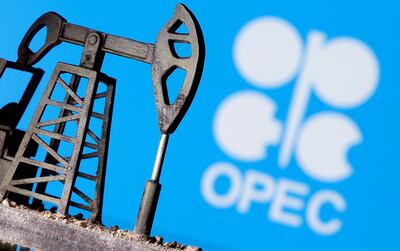Oil prices fell further on Thursday on demand concerns as China, the world’s second-largest economy and the top importer of fuel, continues to enforce strict Covid-19 movement restrictions amid an increase in the number of infections in the country.
Brent, the benchmark for two thirds of the world's oil, was trading 1.78 per cent lower at $93.94 a barrel at 5.31pm UAE time. West Texas Intermediate, the gauge that tracks US crude, was down 1.84 per cent at $87.90 a barrel.
“Crude prices are falling as energy traders anticipate a brutal period for global growth,” said Edward Moya, senior market analyst for the Americas region at Oanda.
“China factory activity remains depressed and another eurozone record high inflation reading has raised the prospects of much more aggressive ECB [European Central Bank] tightening that could trigger a severe recession.”
China is continuing to enforce its strict zero-Covid strategy to stop the spread of the pandemic. On Thursday, authorities in the country's technology centre Shenzhen ordered the suspension of large events and indoor entertainment activities in the city as the number of infections rose.
The world’s most populous country is also putting Chinese city Chengdu under lockdown as it undertakes mass testing in the city. The restrictions in Chengdu come after Shanghai was shut for two months earlier this year.
Meanwhile, eurozone inflation hit another record high last month as a result of higher energy prices. Inflation in the 19 countries sharing the euro currency rose to 9.1 per cent in August, from 8.9 per cent a month earlier, the latest data shows.
“Oil prices continue to remain under pressure, and we saw a lot of gas coming out of them yesterday,” said Naeem Aslam, chief market analyst at Avatrade.
“Today, the weakness in the Chinese Caixin manufacturing PMI reading has further confirmed that oil demand is going to be hit by a more adverse environment in the coming days.”
Traders will be closely watching next week's Opec+ meeting after Saudi Energy Minister Prince Abdulaziz bin Salman said last week that the group, consisting of the world's top producers, would cut production if required to counter the volatility in oil prices.
“The big question among investors and traders is if Opec will do something about supply cuts while the prices have started to rattle their cage once again,” Mr Aslam said.
“Can Opec+ allow oil prices to fall from their normal levels of the 40s and 50s? The answer to this is that it is highly unlikely that we will see Opec sitting on its hands and doing nothing about the oil supply.”
Soft demand is likely to encounter tighter supply, and this means that in the coming days, oil prices are likely to climb with the new norm between $90 and $100, he said.
Recession fears are also growing around the globe amid higher inflation, the pandemic and the Ukraine conflict.
The International Monetary Fund lowered its growth forecast for the global economy to 3.2 per cent this year, from its previous projection of 3.6 per cent in April, owing to the Ukraine war and the slowdown in China.
“Oil prices fell a second day in a row [on Wednesday], closing out August at $96.49 per barrel in Brent and $89.55 per barrel in WTI,” said Khatija Haque, head of research and chief economist at Emirates NBD.
“The Opec+ meeting next week is the next major catalyst for markets, and the alliance’s advisory body endorsed the Saudi view of a disconnect between physical and futures markets and also revised its expectations for 2023 to a deficit of around 300,000 barrels per day from a 900,000 bpd surplus.”
The Opec+ alliance of 23 producers, including Saudi Arabia and Russia, will meet on September 5 to decide on its future output policy.

Oil prices have been extremely volatile this year. Brent rose by more than 20 per cent since the start of the year, having fallen from a 14-year high when it was within touching distance of $140 a barrel in March after Moscow's invasion in Ukraine began, resulting in sanctions being imposed by the US and the UK on crude imports from Russia.
“Oil has now witnessed three consecutive months of decline, longest streak in more than two years as recessionary angst more than [offset] the enduring physical crude market tightness,” Ehsan Khoman, director of emerging markets research for Europe, the Middle East and Africa at MUFG Bank, said in a research note on Thursday.
“The biggest factor keeping a lid on price rises has been Russian oil supplies that have surprised us [and markets] to the upside. This is placing more upward pressure on product prices and more downward pressure on crude prices, as Russian crude exports remain firm.”
Russia has continued to supply oil to markets such as India and China amid sanctions on its energy imports imposed by the US and its allies.
“What is clear is that the market remains mired in deficit, with Russian output set to decline over the winter alongside higher demand due to gas-to-oil switching and the end of the record SPR [strategic petroleum reserve] release,” Mr Khoman said.
Last month, the International Energy Agency said that the power industry's switch from gas to oil and refining in different countries were pushing up demand for crude higher.
MUFG bank expects Brent crude to average $112 a barrel in the fourth quarter of 2022 amid supply concerns and improved demand.
“Near-term, all eyes are on the Opec+ meeting on September 5 amid prospects of a change in direction from the group,” Mr Khoman said.







